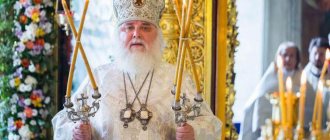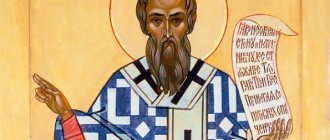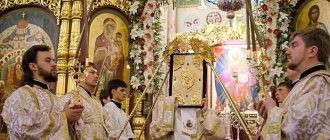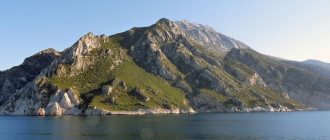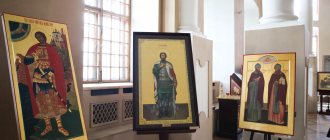Russian Orthodox Church
Story
The first monks settled on the site of the future Lavra in the 14th or 15th centuries. (according to some sources, in the 11th century). The first written mention of the area “Holy Mountains”, in the notes of the German ambassador Sigismund Herberstein, dates back to 1526.
In 1787, by decree of Empress Catherine II, the Svyatogorsk Monastery was abolished, and the villages, lands and lands that belonged to it were taken into the treasury. In 1790, Prince Tauride Grigory Potemkin became the new owner of Svyatogorye. By decree of the Holy Synod, the monastery churches of the Dormition of the Mother of God and St. Nicholas on the rock were converted into parish churches, and the others were dismantled and taken away. The monastery remained in a disused state for almost 57 years.
In 1844, by decree of Emperor Nicholas I, the Svyatogorsk Monastery was restored according to the rank and regulations of the Glinsk Hermitage of the Kursk Diocese. Over the next 70 years, it achieved unprecedented prosperity, becoming one of the largest in the Russian Empire. During this period, the question of assigning the status of a monastery to the Svyatogorsk monastery was raised more than once. The monastery had brick workshops, mills, various workshops, trading shops, was known for its wonderful views and attracted many pilgrims. Before the First World War, about 600 monks labored in the monastery.
The events of 1917 and the advent of Soviet power tragically affected the further fate of the Svyatogorsk Monastery, the looting of which began in January 1918. In 1922, the monastery was liquidated, and in its place a rest house for the workers of Donbass was formed. The time has come for the final destruction of the monastery.
The Svyatogorsk monastery was reopened in 1992 - the plundered and desecrated Assumption Cathedral, turned into a cinema, was given to the monastery.
On September 8, 2000, His Beatitude Metropolitan of Kiev and All Ukraine Vladimir, co-served by Metropolitan Agafangel of Odessa and Izmail, Archbishop of Gorlovka and Slavic Hilarion, Viceroy of the Kiev-Pechersk Lavra Bishop of Vyshgorod Pavel, Bishop of Izyum Onuphry, consecrated the Assumption Cathedral - the main temple of the Svyatogorsk oblast tel.
By the end of 2003, the residential and economic buildings that were under the jurisdiction of the Slavyanogorsk Historical and Architectural Reserve and the “Holy Mountains” sanatorium were finally transferred to the Svyatogorsk Monastery.
On March 9, 2004, the Synod of the Ukrainian Orthodox Church decided to assign the monastery the status of a lavra.
On July 12, 2008, the glorification of the Council of the Holy Fathers took place, shining in the Holy Mountains on the Donets. The Council of the Svyatogorsk Fathers included 17 saints: one saint, 11 saints, 4 holy confessors and one fool for Christ. The decision to canonize 16 of them was made at a meeting of the Synod of the UOC on May 8, 2008 (magazine No. 38). The Monk John, the recluse of Svyatogorsk, was glorified on August 24, 1995.
Temples and chapels located on the territory of the Svyatogorsk Lavra
- Assumption Cathedral (1859-1868);
- Intercession Church (1850);
- Nicholas Church (17th century);
- cave temple of the Nativity of John the Baptist (until the 16th century);
- cave temple of St. Alexy, man of God (1861);
- cave temple of St. Anthony and Theodosius of Pechersk (until the 18th century);
- Church of the Nativity of the Blessed Virgin Mary (2011);
- Church of St. the prophet King David (2011);
- Church of All Reverend Fathers, who shone in feat (2011);
- chapel ap. Andrew the First-Called (mid-1850s);
- water chapel (2004);
- Chapel of St. Arseny and German Svyatogorsky (2009);
- Chapel of the Reverend Fathers of Kiev-Pechersk (2013);
- overlay chapel (under construction);
- Cyril and Methodius Staircase (restored in 2013).
Temples and chapels located outside the territory of the Svyatogorsk Lavra
- the temple of the martyrs Vera, Nadezhda, Lyubov and their mother Sophia in Svyatogorsk;
- monastery of St. Anthony and Theodosius of Kiev-Pechersk;
- All Saints Skete;
- skete in honor of the icon of the Mother of God “Joy of All Who Sorrow” in the village. Bogorodichnoe, Donetsk region;
- St. George's monastery in the village. Valley of Donetsk region;
- monastery of St. John of Shanghai in the village. Adamivka, Donetsk region;
- Nikolo-Feodosievsky monastery in the village. Karmazinovka, Lugansk region.
Shrines
The miraculous Svyatogorsk Icon of the Mother of God, the “Kazan” and “Three-Handed” icons of the Mother of God, the revered icons of St. Nicholas the Wonderworker, the image of the Archangel Gabriel, the icon of the Great Martyr Barbara and the Martyr Tatiana, the relics of St. John the Recluse, the relics of the Venerable Fathers of Svyatogorsk, the myrrh-streaming head of the martyr Eunician of Crete.
Divine service
Morning worship every day at 6.00. Evening service the day before at 17.00.
***
The vicar is Metropolitan Arseny of Svyatogorsk.
Miracle of rebirth
Then everything was a novelty, even the very concept of a monastery did not fit into any patterns of the post-Soviet period. For people of that time, believing Orthodox Christians, especially if they were wearing cassocks or monastic robes, seemed like some kind of aliens or crazy people who suddenly appeared out of nowhere in a completely atheistic society. And in these parts, religion was persecuted very harshly, so much so that people for a long time lost the memory of the past, their roots, their shrines and real heroes and saints.
And the Svyatogorsk Lavra itself did not yet exist in June 1992, nor did the monastery - it was just waking up from a long sleep and was in desolation and desecration for exactly 70 years. And now very strange things and very strange meetings and conversations with people began to happen here. As soon as the monk appeared on the alley, he was immediately surrounded by a group of vacationers, and long conversations of a very different nature began. And there was no feeling of any aggression, there was surprise and a strong thirst for something very important, human, real. After all, these people came here to be treated and take care of their bodies, but suddenly they found out that they have a soul, there is eternity and some kind of God above the entire universe, there are His real disciples and servants, whom you can even touch and listen to. It was a time of neophytes and special grace for believers, when they, even without special religious knowledge, perceived everything with a pure heart and ardent faith. And most often, no matter how pretentious and deliberate it may seem, the people of the Church spoke to others not from themselves, but through themselves. Because they were simple, naive, sincere, and there was little that prevented their charisma from showing. The first Christians of the monastery at the end of the 20th century were like children, and therefore God helped them.
And people helped, everyone in any way they could: some with food, some donated what was needed for the temple, some worked in the maintenance yard or cleared away rubble. I remember one day the governor lamented that they had no bread, and then suddenly a grain truck arrived and the driver gave him as much as he needed. The second hieromonk was transporting his belongings from the Donetsk diocese and was delayed; while unloading, I carelessly broke the glass on the icon, on which the name of the saint was written in golden Church Slavonic letters. How horrified I was when they told me that this was the name Silouan, and the icon of that monk’s heavenly patron. Imagining the man’s grief and realizing my shame, I ran up the huge stairs to the second floor and there, in solitude, bowed. Later, having descended, I wandered up towards a deserted place and suddenly in the twilight I met a man... with glass. It’s unclear where a glazier came from in a vacant lot and cut the glass to the required size right in front of me. And there were many such examples in those days.
And the first monk and abbot of the monastery is still alive and is the confessor for pilgrims and monks; many people come to him from afar. His condition is painful, but spiritually he is young and bright. Archimandrite Seraphim (Lavrik), and before his tonsure, Father Nikolai, as I remember him, remained as simple and real. If at that time they had shown me what the monastery would be like in 25 years, I might have believed it, but only as a great miracle. And the Svyatogorsk Lavra is a real miracle and spiritual pearl not only of Donbass, but of our entire Orthodoxy.
This wonderful place is located in the southeast of Ukraine on the border of the Kharkov and Donetsk regions, known to everyone as Svyatogorye, the Holy Mountains. One of the oldest monasteries in Rus', with cave temples and hermitages. The first monks were settlers from the south who climbed along river beds; according to the main version, they were monks of the Athonite tradition. The Seversky Donets, a beautiful river, brought them here. It was navigable and rich in fish, and I once caught huge bream in it. In recent years, the river has become significantly shallower, but is still considered the most important source of water for Donbass.
Prosphornia
My friend and classmate has been in the Svyatogorsk Lavra for more than twenty years, he is a monk, Hierodeacon Nektariy. His main obedience is prosphora, that is, daily baking of prosphora for worship. I was interested to see the monastic prosphora, and I also looked around the utility yard. There is a forge, a carpentry workshop, a greenhouse, a flower garden, and maybe something else in the buildings that I didn’t notice. Although the main economic territory is located behind the monastery, there are also greenhouses, an apiary, a barnyard, and tractors for cultivating their fields. The monastery is somewhat similar to an ideal mini-model of a state, where everything is clear and orderly, calm and measured, everything ticks like a watch. This usually happens in all monasteries, male and female, small and large, such dormitories are like anthills, where each resident-builder has his own place, and all the brethren have a goal and a common cause.
Chapel of Apostle Andrew
Andrei Muravyov, the brother of the famous Decembrist, a friend of Pushkin, a man to whom Lermontov dedicated more than one poem, often visited the Potemkin estate and was very interested in the life of the monastery. In the name of his Angel - Andrew the First-Called - the chapel was consecrated. It was about this place that Saint Philaret said in the 16th century: “Here is so close to heaven and so far from earth! If you don’t learn to pray here, then where?!” The Chapel of Apostle Andrew in the Svyatogorsk Monastery was built in the mid-19th century. I really like the magnificent viewpoint near the chapel: the height and view are amazing. And a few decades ago there were ruins and dilapidated buildings painted by tourists. The monks repaired the structure and erected a cross.
Saint John of Svyatogorsk
Nothing is known about the ancient hermits, but the famous 19th-century hermit John of Svyatogorsk was in voluntary prayerful confinement for 17 years. Back in 1992, the relics of St. John of Svyatogorsk were kept under wraps. I remember the path to the saint's grave through the forest. Truly, as in the words of the great Pushkin’s poem: “the people’s path will not be overgrown.” Holiness was manifested even in the fact that people possessed by a demon could not be near the burial site. Before my eyes, four healthy men could barely hold a fragile woman with whom mystical things were happening, like in some horror movie. And how many people were there during the glorification of the recluse... How many years passed after the death of the righteous man, and God resurrected his name for the Church - and She found a saint and a man of prayer.
Monastic peacocks and mandarin ducks
The Svyatogorsk Lavra greets the morning with the ringing of bells and the chirping of parrots and other birds. There are fountains along the façade of the central Assumption Church of the monastery, and a poultry house is built in the backyard. It’s a good place for children and adults to relax; you can go out during a long service and relax for a couple of minutes. Everything is clean, no smell. What surprised me most was that there were heat-loving parrots and peacocks outside in such cold weather. I really liked the colored mandarin ducks. Early in the morning, when dawn had just broken and there were no people yet, they grunted funny and loud on the water. The monastery parrots chirped. A new day was starting for everyone.
First days
Svyatogorsk Monastery in 1947. Photo: Svlavra.church.ua
I will not describe in detail the details of the desolation, but to understand the essence of what was happening in those days, we can say that there was a cinema in the main Assumption Cathedral, so the temple was covered with reinforced concrete slabs on two floors. It had just been liberated from its previous owners, and on the second floor there were heaps of unnecessary papers, there was a stage in the central aisle, the entire temple was filled with seats, and in the side altars there were... public toilets. How great was the anger of those who took advantage of the situation and staged such mockery within the walls of the church, where the Eucharist had previously been celebrated. There is no other way to describe it than madness. But everything passes, and different times have come.
A lot of rubbish was removed from the cathedral, including after the reconstruction of the temple in subsequent years and the demolition of the ugly projectionist’s extension at the entrance. The current rector of the Svyatogorsk Lavra, Metropolitan Arseny, who since 1995 has been taking care of the brethren and the Lavra - their common home, can tell you in detail about all this.
God gave me the opportunity to be present here at the first service and the first Liturgy, the first patronal feast, and to celebrate the first Easter. It is interesting that when they were holding the first evening service in a huge empty and desecrated church, among rubbish and broken chairs, suddenly there was such thunder over the domes that it was even scary from surprise. And I have never felt such silence as there was on the first Holy Saturday before Easter. Living the summer in a monastery, touching the mysterious, having a hand in something majestic and providential from above is one of the blessings in my life. Temples
Opposite the Assumption Cathedral is the Intercession Church with a bell tower - during my stay there were treatment rooms and rooms for people relaxing in pajamas. The cross and bells, of course, were missing, and when we first climbed up, we were cleaning up pigeon droppings with bags. Over the decades, a lot of rubbish has accumulated. Trees grew on the roof... But the monastery clock was repaired, now it strikes with a melody. The installation of the first bell was exciting: both technically and financially (the monastery was very poor at that time). But when the ringing spread throughout the area, the Holy Mountains came to life and began to speak.
On one of the mountains there is a monument to the revolutionary Artem. Reinforced concrete 26-meter structure, an imprint of the era of Soviet power. There is a legend associated with this statue: when the monastery brethren decided to build a temple in the 19th century, they asked Isaac (now a saint) if he was a holy fool. He put his hand, peered at the mountain and said that there was no point in doing this, there would be a human being standing there, i.e. they would have destroyed the building anyway.

